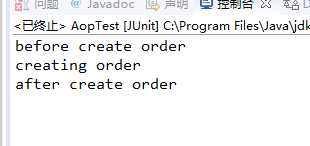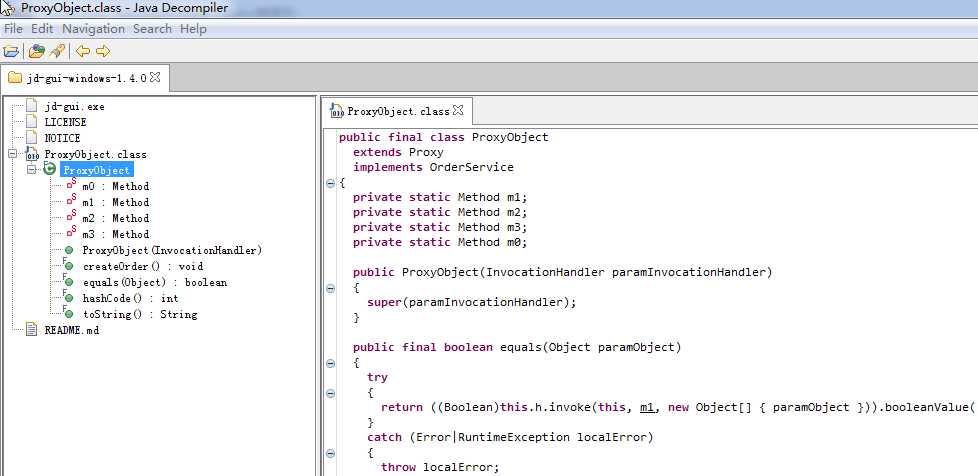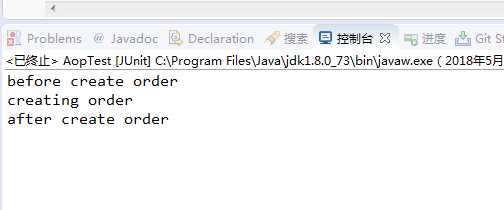标签:对象 loader ret 多重 failure ice 针对 tcl static
AOP:Aspect-Oriented Programming(面向切面编程),维基百科的解释如下:Aspect是一种新的模块化机制,用来描述分散在对象、类或者函数中的横切关注点,从关注点中分离出横切关注点是面向切面的程序设计的核心概念。分离关注点使解决特定领域问题的代码从业务逻辑中独立出来,业务逻辑的代码中不在含有针对特定领域问题的代码的调用,业务逻辑同特定领域问题的关系通过切面来封装、维护,这样原本分散在整个应用程序中的变动就可以很好地管理起来。从AOP的角度,应用可以分为横切关注点和业务逻辑代码,实际开发中,这些横切关注点往往会直接嵌入到业务逻辑代码中,面向切面编程就是要解决把横切关注点与业务逻辑相分离
实现方式:
Spring默认使用 JDK 动态代理作为AOP的代理,缺陷是目标类的类必须实现接口,否则不能使用JDK动态代理。如果需要代理的是类而不是接口,那么Spring会默认使用CGLIB代理,关于两者的区别:jdk动态代理是通过java的反射机制来实现的,目标类必须要实现接口,cglib是针对类来实现代理的,他的原理是动态的为指定的目标类生成一个子类,并覆盖其中方法实现增强,但因为采用的是继承,所以不能对final修饰的类进行代理。
Jdk动态代理是在程序运行过程中,根据目标类实现的接口来动态生成代理类的class文件,使用主要涉及两个类:
InvocationHandler接口: 它提供了一个invoke(Object obj,Method method, Object[] args)方法供实现者提供相应的代理逻辑的实现。可以对实际的实现进行一些特殊的处理其中参数
Object obj :被代理的目标类
Method method: 需要执行的目标类的方法
Object[] args :目标方法的参数
Proxy类:提供一个方法newProxyInstance (ClassLoader loader, Class[] interfaces, InvocationHandler h)来获得动态代理类
示例代码:
public interface OrderService { public void createOrder(); }
public class OrderServiceImpl implements OrderService { @Override public void createOrder() { System.out.println("creating order"); } }
public class OrderLogger { public void beforeCreateOrder(){ System.out.println("before create order"); } public void afterCreateOrder(){ System.out.println("after create order"); } }
package com.sl.aop; import java.lang.reflect.InvocationHandler; import java.lang.reflect.Method; import java.lang.reflect.Proxy; public class ServiceProxy implements InvocationHandler { private Object targetClass; private OrderLogger orderLogger; public ServiceProxy(Object targetClass,OrderLogger orderLogger) { this.targetClass = targetClass; this.orderLogger = orderLogger; } //获取代理 public Object GetDynamicProxy() { return Proxy.newProxyInstance(targetClass.getClass().getClassLoader(), //通过这个ClassLoader生成代理对象 targetClass.getClass().getInterfaces(),//代理类已实现的接口 this); //动态代理调用方法是关联的InvocationHandler,最终通过此InvocationHandler的invoke方法执行真正的方法 } //实现相应的代理逻辑 @Override public Object invoke(Object proxy, Method method, Object[] args) throws Throwable { this.orderLogger.beforeCreateOrder(); Object result= method.invoke(targetClass, args); this.orderLogger.afterCreateOrder(); return result; } }
测试类:
package com.sl.aop; import org.junit.Test; public class AopTest { @Test public void Testdynamicproxy() { OrderServiceImpl serviceImpl = new OrderServiceImpl(); OrderLogger logger = new OrderLogger(); OrderService service = (OrderService) new ServiceProxy(serviceImpl, logger).GetDynamicProxy(); service.createOrder(); } }
运行结果:

到这个其实还是有点困惑,Proxy.newProxyInstance()这个返回的是什么? Invoke方法在哪里调用的?我们看一下JDK源码:看看DK动态代理的过程是什么样的:
根据源码内部的函数调用Proxy.newProxyInstance()->Proxy.getProxyClass0()->WeakCache.get() ,先定位到
WeakCache.class:
public V get(K key, P parameter) { Objects.requireNonNull(parameter); expungeStaleEntries(); Object cacheKey = CacheKey.valueOf(key, refQueue); // lazily install the 2nd level valuesMap for the particular cacheKey ConcurrentMap<Object, Supplier<V>> valuesMap = map.get(cacheKey); if (valuesMap == null) { ConcurrentMap<Object, Supplier<V>> oldValuesMap = map.putIfAbsent(cacheKey, valuesMap = new ConcurrentHashMap<>()); if (oldValuesMap != null) { valuesMap = oldValuesMap; } } // create subKey and retrieve the possible Supplier<V> stored by that // subKey from valuesMap Object subKey = Objects.requireNonNull(subKeyFactory.apply(key, parameter)); Supplier<V> supplier = valuesMap.get(subKey); Factory factory = null; while (true) { if (supplier != null) { // supplier might be a Factory or a CacheValue<V> instance V value = supplier.get(); if (value != null) { return value; } } // else no supplier in cache // or a supplier that returned null (could be a cleared CacheValue // or a Factory that wasn‘t successful in installing the CacheValue) // lazily construct a Factory if (factory == null) { factory = new Factory(key, parameter, subKey, valuesMap); } if (supplier == null) { supplier = valuesMap.putIfAbsent(subKey, factory); if (supplier == null) { // successfully installed Factory supplier = factory; } // else retry with winning supplier } else { if (valuesMap.replace(subKey, supplier, factory)) { // successfully replaced // cleared CacheEntry / unsuccessful Factory // with our Factory supplier = factory; } else { // retry with current supplier supplier = valuesMap.get(subKey); } } } }
可以看到函数return value; 而 V value = supplier.get(); 继续往下读可以发现 supper=factory,实际上是一个Factory对象,那么继续查看Factory.get()方法
public synchronized V get() { // serialize access // re-check Supplier<V> supplier = valuesMap.get(subKey); if (supplier != this) { // something changed while we were waiting: // might be that we were replaced by a CacheValue // or were removed because of failure -> // return null to signal WeakCache.get() to retry // the loop return null; } // else still us (supplier == this) // create new value V value = null; try { value = Objects.requireNonNull(valueFactory.apply(key, parameter)); } finally { if (value == null) { // remove us on failure valuesMap.remove(subKey, this); } } // the only path to reach here is with non-null value assert value != null; // wrap value with CacheValue (WeakReference) CacheValue<V> cacheValue = new CacheValue<>(value); // try replacing us with CacheValue (this should always succeed) if (valuesMap.replace(subKey, this, cacheValue)) { // put also in reverseMap reverseMap.put(cacheValue, Boolean.TRUE); } else { throw new AssertionError("Should not reach here"); } // successfully replaced us with new CacheValue -> return the value // wrapped by it return value; }
Return value;那么直接查看赋值语句:value = Objects.requireNonNull(valueFactory.apply(key, parameter)); valueFactory又什么鬼?
public WeakCache(BiFunction<K, P, ?> subKeyFactory, BiFunction<K, P, V> valueFactory) { this.subKeyFactory = Objects.requireNonNull(subKeyFactory); this.valueFactory = Objects.requireNonNull(valueFactory); } private static final WeakCache<ClassLoader, Class<?>[], Class<?>> proxyClassCache = new WeakCache<>(new KeyFactory(), new ProxyClassFactory());
可以知道valueFactory是ProxyClassFactory类型对象,直接查看ProxyClassFactory. Apply()方法
public Class<?> apply(ClassLoader loader, Class<?>[] interfaces) { Map<Class<?>, Boolean> interfaceSet = new IdentityHashMap<>(interfaces.length); for (Class<?> intf : interfaces) { /* * Verify that the class loader resolves the name of this * interface to the same Class object. */ Class<?> interfaceClass = null; try { interfaceClass = Class.forName(intf.getName(), false, loader); } catch (ClassNotFoundException e) { } if (interfaceClass != intf) { throw new IllegalArgumentException( intf + " is not visible from class loader"); } /* * Verify that the Class object actually represents an * interface. */ if (!interfaceClass.isInterface()) { throw new IllegalArgumentException( interfaceClass.getName() + " is not an interface"); } /* * Verify that this interface is not a duplicate. */ if (interfaceSet.put(interfaceClass, Boolean.TRUE) != null) { throw new IllegalArgumentException( "repeated interface: " + interfaceClass.getName()); } } String proxyPkg = null; // package to define proxy class in int accessFlags = Modifier.PUBLIC | Modifier.FINAL; /* * Record the package of a non-public proxy interface so that the * proxy class will be defined in the same package. Verify that * all non-public proxy interfaces are in the same package. */ for (Class<?> intf : interfaces) { int flags = intf.getModifiers(); if (!Modifier.isPublic(flags)) { accessFlags = Modifier.FINAL; String name = intf.getName(); int n = name.lastIndexOf(‘.‘); String pkg = ((n == -1) ? "" : name.substring(0, n + 1)); if (proxyPkg == null) { proxyPkg = pkg; } else if (!pkg.equals(proxyPkg)) { throw new IllegalArgumentException( "non-public interfaces from different packages"); } } } if (proxyPkg == null) { // if no non-public proxy interfaces, use com.sun.proxy package proxyPkg = ReflectUtil.PROXY_PACKAGE + "."; } /* * Choose a name for the proxy class to generate. */ long num = nextUniqueNumber.getAndIncrement(); String proxyName = proxyPkg + proxyClassNamePrefix + num; /* * Generate the specified proxy class. */ byte[] proxyClassFile = ProxyGenerator.generateProxyClass( proxyName, interfaces, accessFlags); try { return defineClass0(loader, proxyName, proxyClassFile, 0, proxyClassFile.length); } catch (ClassFormatError e) { /* * A ClassFormatError here means that (barring bugs in the * proxy class generation code) there was some other * invalid aspect of the arguments supplied to the proxy * class creation (such as virtual machine limitations * exceeded). */ throw new IllegalArgumentException(e.toString()); } } }
直接画重点:
byte[] proxyClassFile = ProxyGenerator.generateProxyClass( proxyName, interfaces, accessFlags); return defineClass0(loader, proxyName, proxyClassFile, 0, proxyClassFile.length);
调用ProxyGenerator.generateProxyClass最终动态生成一个代理类,但是似乎并未找到何处调用了invoke方法;参考CSDN: https://blog.csdn.net/jiankunking/article/details/52143504这边文章,尝试将这个动态生成的二进制字节码输出到本地,并反编译出来一看究竟,测试代码如下:
public class AopTest { @Test public void Testdynamicproxy() { OrderServiceImpl serviceImpl = new OrderServiceImpl(); OrderLogger logger = new OrderLogger(); OrderService service = (OrderService) new ServiceProxy(serviceImpl, logger).GetDynamicProxy(); service.createOrder(); //输出动态代理类字节码 createProxyClassFile(); } private static void createProxyClassFile(){ String name = "ProxyObject"; byte[] data = ProxyGenerator.generateProxyClass(name,new Class[]{OrderService.class}); FileOutputStream out =null; try { out = new FileOutputStream(name+".class"); System.out.println((new File("hello")).getAbsolutePath()); out.write(data); } catch (FileNotFoundException e) { e.printStackTrace(); } catch (IOException e) { e.printStackTrace(); }finally { if(null!=out) try { out.close(); } catch (IOException e) { e.printStackTrace(); } } } }
使用java Decompiler工具将这个二进制class文件反编译查看:

具体动态代理类ProxyObject.java:
import com.sl.aop.OrderService; import java.lang.reflect.InvocationHandler; import java.lang.reflect.Method; import java.lang.reflect.Proxy; import java.lang.reflect.UndeclaredThrowableException; public final class ProxyObject extends Proxy implements OrderService { private static Method m1; private static Method m2; private static Method m3; private static Method m0; public ProxyObject(InvocationHandler paramInvocationHandler) { super(paramInvocationHandler); } public final boolean equals(Object paramObject) { try { return ((Boolean)this.h.invoke(this, m1, new Object[] { paramObject })).booleanValue(); } catch (Error|RuntimeException localError) { throw localError; } catch (Throwable localThrowable) { throw new UndeclaredThrowableException(localThrowable); } } public final String toString() { try { return (String)this.h.invoke(this, m2, null); } catch (Error|RuntimeException localError) { throw localError; } catch (Throwable localThrowable) { throw new UndeclaredThrowableException(localThrowable); } } public final void createOrder() { try { this.h.invoke(this, m3, null); return; } catch (Error|RuntimeException localError) { throw localError; } catch (Throwable localThrowable) { throw new UndeclaredThrowableException(localThrowable); } } public final int hashCode() { try { return ((Integer)this.h.invoke(this, m0, null)).intValue(); } catch (Error|RuntimeException localError) { throw localError; } catch (Throwable localThrowable) { throw new UndeclaredThrowableException(localThrowable); } } static { try { m1 = Class.forName("java.lang.Object").getMethod("equals", new Class[] { Class.forName("java.lang.Object") }); m2 = Class.forName("java.lang.Object").getMethod("toString", new Class[0]); m3 = Class.forName("com.sl.aop.OrderService").getMethod("createOrder", new Class[0]); m0 = Class.forName("java.lang.Object").getMethod("hashCode", new Class[0]); return; } catch (NoSuchMethodException localNoSuchMethodException) { throw new NoSuchMethodError(localNoSuchMethodException.getMessage()); } catch (ClassNotFoundException localClassNotFoundException) { throw new NoClassDefFoundError(localClassNotFoundException.getMessage()); } }
终于看到关于invoke的部分了:
public final void createOrder() { try { this.h.invoke(this, m3, null); return; } catch (Error|RuntimeException localError) { throw localError; } catch (Throwable localThrowable) { throw new UndeclaredThrowableException(localThrowable); } }
实际上动态代理类继承自Proxy,并且实现了目标类继承的接口,在createOrder方法中调用了invoke方法,实现了切面逻辑的植入,这里也回答了一个问题,为什么JDK动态代理的目标类必须是实现接口的,因为代理类其实是针对接口代理,而不是针对类来代理的,动态代理类自己继承自Proxy,Java也不允许多重继承。动态代理类和目标类其实是各自实现了接口,代理类通过InvocationHandler.invoke实现对目标类方法的调用。
CGLIB代理是通过使用一个字节码处理框架ASM,来转换字节码并生成新的类,并在子类中采用方法拦截的技术拦截所有父类方法的调用,实现织如如横切逻辑 ,效率上比使用反射技术的JDK动态代理要高,但是由于CGLIB的原理是动态为目标类生成子类代理类,所以不能为声明为final的方法进行代理。其使用主要涉及两个类:
MethodInterceptor接口:该接口提供一个方法intercept(Object arg0, Method arg1, Object[] arg2, MethodProxy arg3)主要用于拦截目标类方法的调用
Object arg0, :被代理的目标类
Method arg1, 委托方法
Object[] arg2, 方法参数
MethodProxy arg3 :代理方法的MethodProxy对象
Enhancer类:用于创建代理类
示例:
实现MethodInterceptor接口
package com.sl.aop; import java.lang.reflect.Method; import org.springframework.cglib.proxy.Enhancer; import org.springframework.cglib.proxy.MethodInterceptor; import org.springframework.cglib.proxy.MethodProxy; public class CglibServiceProxy implements MethodInterceptor { private Object targetClass; private OrderLogger orderLogger; public CglibServiceProxy(Object targetClass,OrderLogger orderLogger) { this.targetClass = targetClass; this.orderLogger = orderLogger; } /** * 创建代理对象 * */ public Object getInstance() { Enhancer enhancer = new Enhancer(); //设置目标类(需要被代理的类) enhancer.setSuperclass(this.targetClass.getClass()); // 回调方法 enhancer.setCallback(this); // 创建代理对象 return enhancer.create(); } /** * 拦截所有目标类方法的调用 * */ @Override public Object intercept(Object arg0, Method arg1, Object[] arg2, MethodProxy arg3) throws Throwable { orderLogger.beforeCreateOrder(); Object o1 = arg3.invokeSuper(arg0, arg2); orderLogger.afterCreateOrder(); return o1; } }
测试方法:
public void Testdynamicproxy() { System.setProperty(DebuggingClassWriter.DEBUG_LOCATION_PROPERTY, "D:\\class"); OrderServiceImpl serviceImpl = new OrderServiceImpl(); OrderLogger logger = new OrderLogger(); CglibServiceProxy proxy = new CglibServiceProxy(serviceImpl,logger); //通过生成子类的方式创建代理类 OrderServiceImpl proxyImp = (OrderServiceImpl)proxy.getInstance(); proxyImp.createOrder(); }
结果:

最后两种代理对比一下:
JDK动态代理:代理类与委托类实现同一接口,主要是通过代理类实现InvocationHandler并重写invoke方法来进行动态代理的,在invoke方法中将对方法进行增强处理 优点:不需要硬编码接口,代码复用率高,缺点:只能够代理实现了接口的委托类
CGLIB动态代理:
标签:对象 loader ret 多重 failure ice 针对 tcl static
原文地址:https://www.cnblogs.com/ashleyboy/p/9027072.html